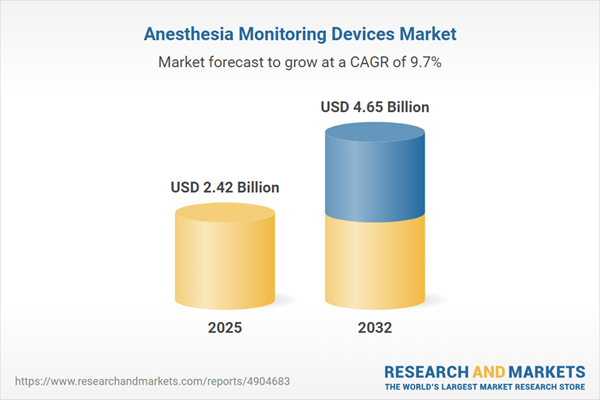Speak directly to the analyst to clarify any post sales queries you may have.
The anesthesia monitoring devices market is evolving rapidly as health systems prioritize integration, patient safety, and regulatory compliance within clinical workflows. Leaders are now balancing operational efficiency and technology adoption to meet the demands of modern perioperative care.
Market Snapshot: Anesthesia Monitoring Devices Market
The global anesthesia monitoring devices market is projected to expand from USD 2.21 billion in 2024 to USD 2.42 billion in 2025, with an expected value of USD 4.65 billion by 2032. This growth follows a compound annual growth rate (CAGR) of 9.74%.
The market trajectory reflects surging demand for high-quality perioperative monitoring, growing adoption of digital health solutions, and increased focus on real-time, comprehensive patient data. Health systems are seeking analytics-driven device integration to ensure accuracy, interoperability, and compliance. Investments in modular, adaptable solutions and global standardization are reinforcing a climate of long-term operational transformation and readiness for regulatory evolution.Anesthesia Monitoring Devices Market Scope & Segmentation
This report provides actionable insight for C-level executives, procurement teams, and clinical operations specialists spearheading investments in anesthesia monitoring technologies. It examines key product categories, major technology pathways, and the global landscape to support strategic planning and resource optimization.
- Product Type: Blood pressure monitors, gas analyzers, multiparameter monitors, capnography systems, pulse oximeters, and temperature monitors establish the core foundation for protocol-driven monitoring in varied clinical environments.
- Technology: Invasive monitoring (such as arterial and intracranial solutions) and noninvasive options (including pulse oximetry, capnography) enable flexible data collection across the patient acuity spectrum and integrate with major electronic health record platforms.
- Application: General, regional, and sedation anesthesia applications allow tailored use of devices across operative schedules, emergencies, and procedures with unique clinical requirements.
- End User: Hospitals, ambulatory surgical centers, outpatient clinics, intensive care units, and emergency departments employ these technologies to accommodate diverse patient populations and acuity scenarios.
- Distribution Channel: Direct manufacturer procurement and distributor-based sourcing deliver multiple purchasing models, supporting financial and inventory management strategies.
- Geography: Market dynamics differ by Americas, Europe, Middle East & Africa, and Asia-Pacific regions, influenced by infrastructure levels, reimbursement systems, and local regulatory policies affecting device adoption and deployment approaches.
- Leading Companies: Key industry innovators—including Baxter International, Criticare Technologies, Drägerwerk AG & Co. KGaA, GE Healthcare, Medtronic PLC, Koninklijke Philips N.V., Nihon Kohden Corporation, Mindray Medical International, Smiths Medical Inc., and Intersurgical Limited—drive technological advances and support competitive differentiation across markets.
Key Takeaways for Executive Procurement and Operations
- Integrating anesthesia monitoring devices within core IT and clinical platforms enables improved access to patient data and enhances regulatory documentation processes across care settings.
- Focusing on noninvasive and minimally invasive monitoring supports reduced training complexity and promotes agile adoption, particularly during onboarding of new staff or procedural updates.
- Wearable and wireless device features extend continuous monitoring into perioperative and non-traditional environments, supporting rapid adjustments and responsive patient management.
- Modular device architecture enhances upgrade flexibility, extending the usable lifetime of capital investments while reducing exposure to disruptive technology shifts.
- Emphasizing maintenance and device reliability minimizes operational delays and sustains high clinical safety benchmarks.
- Strong internal collaboration between suppliers, procurement teams, and clinical staff accelerates procurement cycles and improves response to evolving regulatory or market requirements.
Assessing the Impact of 2025 U.S. Tariff Measures
Forthcoming U.S. tariff regulations prompt hospitals and healthcare entities to reassess sourcing and procurement strategies for anesthesia monitoring devices. Organizations are acting to bolster regional supply chains, increase local manufacturing capacity, and expand supplier diversity to maintain stability during external disruptions. Enhanced inventory management and a greater emphasis on device interoperability and durability help mitigate risk and maintain operational momentum throughout supply chain adjustments.
Methodology & Data Sources
This anesthesia monitoring devices market analysis draws from executive interviews, regulatory and patent reviews, insights from industry conferences, and proprietary research. The methodology ensures robust, executive-oriented data interpretation to underpin commercial decisions.
Why This Anesthesia Monitoring Devices Market Report Matters
- Enables strategic procurement decisions by framing anesthesia monitoring device investments within contemporary clinical and compliance frameworks.
- Presents actionable strategies for optimizing sourcing and implementation models in line with varying infrastructure maturity and digitization priorities worldwide.
- Guides long-term tactical planning by identifying opportunities for operational modernization and sustained advancements in patient care quality.
Conclusion
This report gives healthcare leaders the data-driven perspective needed for confident anesthesia monitoring investment decisions. Leveraging these insights strengthens operational agility and aligns procurement with future regulatory and clinical requirements.
Additional Product Information:
- Purchase of this report includes 1 year online access with quarterly updates.
- This report can be updated on request. Please contact our Customer Experience team using the Ask a Question widget on our website.
Table of Contents
3. Executive Summary
4. Market Overview
7. Cumulative Impact of Artificial Intelligence 2025
Companies Mentioned
The companies profiled in this Anesthesia Monitoring Devices market report include:- Baxter International, Inc.
- Criticare Technologies Inc.
- Drägerwerk AG & Co. KGaA
- GE Healthcare
- Medtronic PLC
- Koninklijke Philips N.V.
- Nihon Kohden Corporation
- Mindray Medical International Limited
- Smiths Medical, Inc.
- Intersurgical Limited
Table Information
| Report Attribute | Details |
|---|---|
| No. of Pages | 181 |
| Published | November 2025 |
| Forecast Period | 2025 - 2032 |
| Estimated Market Value ( USD | $ 2.42 Billion |
| Forecasted Market Value ( USD | $ 4.65 Billion |
| Compound Annual Growth Rate | 9.7% |
| Regions Covered | Global |
| No. of Companies Mentioned | 11 |









